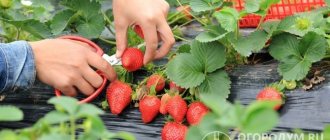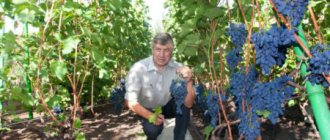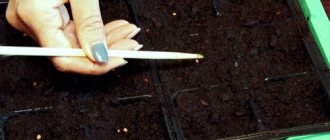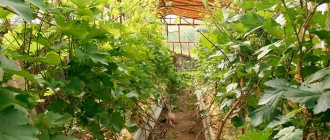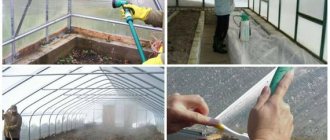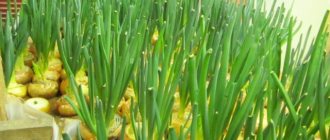I used to be skeptical about growing grapes in Western Siberia. And when winegrowers gave lectures in our clubs, I never listened to them, because I believed that grapes were not a Siberian crop. Several years ago, at an exhibition, I met a winegrower from the Novosibirsk region, Mikhail Koryagin, and was simply amazed that in Siberia it is possible to grow large-fruited table varieties that are ripened and very tasty. However, I refused to grow grapes in trenches. Instead, she began to successfully grow grapes in a greenhouse.
When I read information on the Internet about growing grapes, I came across recommendations that under the bushes you need to dig holes 3 m deep and make drainage. In the trench method, the covering process is also quite labor-intensive. The first experience of growing in a trench was not entirely successful. After winter, 30% of my young vines died. If you just imagine all this work, you immediately give up. In fact, everything is much simpler if you grow grapes in a greenhouse. I thought: we grow cucumbers and tomatoes in greenhouses and get good results. So why not do the same with grapes?
Introduction
Unfavorable climatic conditions and invasions of parasitic insects make it impossible to grow varietal grapes in most regions.
But this fact does not prevent residents of mid-latitudes from feasting on sweet, juicy fruits, proving to the southern region the cunning and dexterity of agricultural technology.
Greenhouses come to the aid of gardeners, which retain heat, transmit sunlight and retain nutrient moisture. It is enough just to control the process and apply fertilizers in order to have a harvest in 3-4 months.
Care
Caring for young and then fruit-bearing grapes comes down to systematic watering, formation of shoots, and control of the microclimate. The environment should be comfortable for the crop - the growth of the grape bush will depend on the temperature, amount of sunlight and looseness of the soil.
Features of watering
Greenhouse grapes are watered less often than ground grapes, since the moisture in the greenhouse remains in the soil longer. For the first time, the bush is watered immediately after planting. Then, as soon as it is well rooted, watering is carried out once every 7-10 days, as the top layer of soil dries. During the period of flowering and fruit ripening, the plant requires less moisture. From early July to mid-August, the plant is watered once every two weeks.
Important!
Good ventilation is important for grapes, as they do not tolerate waterlogging.
Temperature
For grapes growing in protected soil, it is important to maintain a suitable temperature. At the time of planting, the temperature in the greenhouse should be an average of +10 degrees. Then the temperature is gradually increased, reaching +24 degrees by the time the buds open. At night, the plant needs +16-18 degrees. When fruit ovaries appear and the crop begins to ripen, the temperature can rise to +30 degrees - this is the optimal indicator for a grape plant.
By controlling the microclimate of the room, it is important to prevent stuffiness, the accumulation of water condensation on the leaves and stems, and the appearance of an earthen crust. During hot days, it is better to shade the greenhouse with a protective awning, otherwise the berries will begin to wither before they have time to ripen.
Note!
The temperature value depends primarily on the grape variety.
Trimming Features
Grapes can be grown along the eaves of the roof. Then it is better to lead the plant in one stem, and pinch the second, spare one. If the greenhouse is not too high, then the grapes can be placed along the wall, forming them in the form of a multi-armed cordon. The essence of pruning greenhouse grapes is that it will remove all the extra shoots that grow during the season, which in a limited space quickly thicken the bush and cast a shadow on the fruits.
In cases where other crops grow next to a grape bush, it is given a standard form. Standard grapes can even be grown in a pot. The plant produces few clusters, but they are of high quality and very good taste.
Formation begins immediately after planting the seedling. Initially, the trunk is severely pruned, and in subsequent years all regrown shoots are shortened by half, cutting off all unripe green areas. To prevent side shoots from growing too quickly, they are pinched in the summer and removed during autumn pruning. The height of the trunk can be up to one meter. Higher up the growth of lateral branches begins. The crown is formed in such a way that up to two buds remain on each shoot during autumn pruning. All side stepsons are completely removed. Gradually, the main short strong branches will form on the bush. In summer, stems will grow from these branches, which are trimmed as soon as they reach 40 cm in length.
To obtain larger berries and voluminous bunches, it is necessary to free the shoots from excess fruit ovaries, otherwise there will be a lot of clusters, but they will grow small and loose. Removing small fruits, weak branches, dried and yellowed leaves will help prevent overload.
Help with pollination
Self-pollinating grape varieties, that is, those whose flowers have organs of both sexes, are optimally suited for the greenhouse. This approach is due to the fact that pollinating bees rarely enter the greenhouse, and therefore pollination may not occur, and therefore there will be no harvest. If you cultivate a bee-pollinated variety, you will have to carry out pollination yourself. When the flowers are fully open, you need to tap the branches or flowers so that the pollen from the male flowers falls onto the female ones. To ensure efficiency, a fan is installed in the greenhouse to spread pollen by the wind.
Top dressing
In the first year after planting, grapes do not need fertilizing. But this is provided that the land was generously fertilized when the beds were planted. Otherwise, the crop needs fourfold application of fertilizers:
- In the spring. Organic matter in the form of ammonium nitrate or urea, potassium salt, and superphosphate are added into trenches 25 centimeters deep dug next to the bush. The share of nitrogen fertilizers at this stage should be 45%, the share of potassium fertilizers – 25%, the share of phosphorus fertilizers – 30%.
- Two weeks before flowering. This time the land is supplied with organic matter (diluted mullein, compost, chicken droppings), 20 grams of potassium sulfate and 25 grams of superphosphate diluted in water.
- The appearance of berries. Carry out foliar feeding with microelements.
- Ripening of berries. The share of phosphorus and potassium fertilizers is doubled. Nitrogen is completely excluded. Wood ash can replace potassium at this stage.
Shelter for the winter
After harvesting, final watering is carried out at the end of September. Moisture will nourish the roots in winter. The vines are removed from the trellises and dug trenches are laid - this will provide the wood with warmth and prevent frostbite. The top of the shoots is covered with spruce branches, straw, dry grass, and sawdust. You can spray the bushes with insecticides and fungicides in advance to prevent the disease from occurring.
It is better if the walls and roof of the greenhouse are removed. In this case, the frame must be disassembled so that the snow creates a reliable protective layer for the grape vines.
By the way!
For the winter, grapes can be covered with non-woven material, for example, roofing felt, agrofibre.
Why are grapes in a greenhouse profitable and convenient?
If the idea of enjoying juicy fruits does not leave you all summer and autumn, and you have an ownerless greenhouse, you should definitely use it wisely by planting several grape bushes. The advantages of this growing method are:
- It grows quickly - the first fruits can be harvested as early as June.
- The brushes are larger and heavier - enough not only for food and preparations, but also for sale, which will not only cover all the costs of the greenhouse, but will also be an excellent option for additional income.
- There are no invasions of ants, wasps, mole crickets - with timely treatments there is also no chlorosis and powdery mildew.
- Automation of the growing process at all stages - a greenhouse helps reduce the time spent caring for grapes.
- You can plant several varieties - early and middle ones will be ready for use by June-July, and later ones will ripen by August-September.
- Greens and flowers grow well in the root zone, which can also be grown for sale.
Plant young seedlings at intervals. For example, 3 bushes will be planted in March, 3 in April and another 2-3 towards the end of May. This will allow you to provide yourself with grapes for a long period. The first fruits will ripen by the beginning of summer, and those bushes that were planted last will delight you with a generous harvest in the fall and for the New Year.
But you don’t need to think that burying a seedling and watering it as needed is the whole growing process. To get a really good harvest, you need to think through all the nuances.
The need for a garter
The grapes grow quickly and entwine neighboring trees and outbuildings. Randomly growing vines intertwine with each other, turning the vineyard into thickets. But if the bushes are tied up, the planting takes on a cultivated appearance.
Benefits of tying grapes:
- the bush receives more oxygen and is less susceptible to fungal infection;
- the clusters are well illuminated by the sun, ripen faster, the bush produces large berries;
- the plant looks neat;
- each vine is available for care and harvesting;
- the flowers of the straightened branch are open for pollination;
- shoot growth can be controlled;
- the bush sends out shoots evenly.
Garter is required for growing on farms. The dacha and vegetable garden occupy a small plot of land, but even there the grapes need a garter, as it saves space.
Features of growing grapes in a greenhouse
Grapes are a heat-loving plant, so if you don’t have a heated greenhouse at your disposal, then this option is definitely not suitable for you. To get a good harvest, you need to take into account the following nuances and features:
- Soil type - the best option is sandstone, which forms an alkaline environment. It can be mixed with chernozem and alumina in equal proportions.
- Depth of the bed - grapes have a developed root system that goes several meters into the ground. Therefore, the recommended depth for cultivating the beds is at least 1 m.
- The choice of variety is given priority to hybrids that ripen quickly and exhibit increased resistance to negative environmental factors.
- Location of the greenhouse - in order to have a lot of sunlight and, accordingly, heat, the greenhouse should be located in an open area, away from massive buildings and plantings that can create shadow.
- Irrigation system - drip option is optimal, as it saves time and effort on watering.
- Supports – for heavy vines, form stable supports that can withstand the weight of a large bunch.
- Feeding and spraying - despite the closed growing system, the shrub needs monthly feeding, as well as spraying against fungal diseases.
- Heating – if in summer the air temperature barely reaches 15°C during the day, then heating should be installed in the greenhouse. The best way to cope with the problem is heating in the form of a stove in which fuel bars are burned. They are relatively inexpensive, but have a heat capacity an order of magnitude higher than wood and coal.
- Lighting – with short daylight hours from the end of March to the beginning of May, the grapes need additional lighting. It is best to use phyto-lamps, the spectrum of which activates all metabolic processes and accelerates the process of releasing the peduncle. By May, when daylight hours are around 12 hours, the grapes will be ready for active vegetation and pollination.
- Ventilation - despite the heat-loving nature, greenhouse vineyards should be ventilated. This should be done in the middle of the day, when the air outside the greenhouse is as warm as possible.
If these 10 points do not make you want to abandon the idea of growing grapes in a greenhouse, then let’s move on to the next step. As for organization, it is best to install a greenhouse in the fall, and plant young seedlings in early spring, but more on that in order.
Tools
In addition to the usual tools that every gardener has, some special devices are used in viticulture. Since gartering grapes is considered the most labor-intensive procedure, which is carried out repeatedly, devices have been developed to help the winegrower to facilitate this process.
Staplers
Staplers or tapeners are especially useful in large vineyards, when the gartering procedure can take several hours. With just one press of the lever, the grape branch will be securely fixed to a wire or other support. The entire garter operation takes no more than a second and can be performed with one hand.
This device is loaded with a reel of garter tape and a cassette with metal staples.
Garter cord
The disadvantage of the stapler is its high price, so in small vineyards you can use hand-tying. In this case, it is better not to use homemade bindings, but to use a garter cord. It is made of metal wire wrapped in special paper.
Scissors for knitting loops
Loop scissors are a tool that is used to secure grape branches to a trellis using a garter cord. This kit will cost less than a stapler and is usually used on small garden plots.
Greenhouse organization
According to experts, polycarbonate greenhouses are the best for growing grapes. Their advantages are:
- Increased strength - film analogues wear out over time, crack and require expensive repairs. The service life of polycarbonate is within 30-45 years.
- Does not bend under a layer of snow - the material can withstand the thickness of the snow, and when it melts, it rolls off on its own, without causing the formation of icing.
- Retains moisture and heat, allows the sun's rays to pass through - the grapes feel more than comfortable in such conditions.
The optimal requirements for the greenhouse in which grapes will be grown are:
- The height is at least 1.8 m so that the lashes can reach the required length.
- Width – at least 2 m, for the arrangement of two parallel beds.
- Length is at personal discretion, but for 10 bushes 4-5 m is enough.
- Mandatory presence of a path and separation of the beds from the passage by the side.
- Organization of supports on which the whips will be attached.
- Mandatory transoms and doors for ventilation.
- The presence of a foundation that will protect the soil in the beds from freezing in winter.
It is better to install a greenhouse at the end of autumn, when the main work is completed. It is prepared for wintering, namely:
- They take out old growth and remove the top layer of soil in the beds.
- Humus and manure are laid out and snow is added on top.
- Mineral fertilizers are applied in the form of calcium and potassium.
- Treat the walls with a spray bottle and an antiseptic solution.
If there are already grape seedlings in the greenhouse, in winter all the side vines are cut off, leaving only the main trunk. The roots are dug in and fallen leaves are placed on top, which will protect the bush from freezing.
Grape business income
| Product | price, rub. | Qty | Amount, rub. |
| Grapes wholesale, kg | 50 | 25000 | 1250000 |
| Retail grapes, kg | 100 | 5000 | 500000 |
| Grape seedlings, pcs. | 200 | 500 | 100000 |
| Total: | 1850000 |
As you can see, planting a vineyard is slightly less profitable than growing raspberries as a business, but this does not prevent the farmer from recouping the initial costs in just seven years, of which he will wait three years for the first harvest:
Profitability of growing grapes
| Index | 3rd year | From 4th year |
| Revenue, rub. | 1850000 | 1850000 |
| Costs, rub. | 1363220 | 525740 |
| Profit, rub. | 486780 | 1324260 |
| Unified agricultural tax, rub. | 29200 | 79460 |
| Net profit, rub. | 457580 | 1244800 |
| Profitability, % | 33,5 | 236,7 |
| Investments, rub. | 5597700 | |
| Payback period, years | 7 |
Selection of young seedlings
Absolutely all grape varieties grow well in a greenhouse, but the best of them are:
- “Michurinsky” are large and juicy fruits that ripen by early June.
- "Arcadia" - large, weighty bunches, an early variety, ideal for eating and making table wines.
- “Kishmish radiant” - suitable for growing in unheated greenhouses, bears fruit from August to November.
- “Beauty of the North” is resistant to pests and is not picky about temperature and lighting.
- "Saturn" - massive clusters, large fruits, early ripening and abundant fruiting.
Michurinsky
Arcadia
Kishmish radiata
Beauty of the North
Saturn
It is recommended to purchase young seedlings from certified sales points, which bear full responsibility for the originality of the variety and the good quality of the material.
Pay attention to the appearance of the seedling. Dark spots, plaque, and an unpleasant musty smell of rot indicate the presence of diseases. A good seedling smells like grapes, has a dense crust on the vine, without signs of deformation or damage.
After purchase, the seedling is placed in water until its growth point. To quickly activate the development of the root system, you can add a few drops of Kornevin to the water. After 2-3 days you can plant it in the greenhouse.
Preparing the greenhouse and planting seedlings
At the end of February and beginning of March, preparatory work is carried out in the greenhouse, namely:
- Digging up beds and disinfecting them - after digging, the soil is generously spilled with a weak solution of manganese to destroy pathogenic bacteria.
- Treatment of walls and ceilings in a greenhouse - water is mixed with Chlorhexidine, the mixture is poured into a sprayer and passed over the entire surface.
- Ventilating the greenhouse and heating the air to the desired temperature, providing additional lighting.
- Disinfection of paths between beds.
- Formation of holes.
The bushes are planted at a distance of 1 m from each other. To do this you need:
- Dig a hole 30-40 cm deep.
- Place a handful of Superphosphate and Saltpeter on the bottom.
- Sprinkle the soil generously and wait until all the water is absorbed.
- Take a seedling, lower it into the hole, sprinkle with dry soil to the growth point.
- Lightly compact so that it does not fall.
- Water with warm water, avoiding contact with the vine.
In 10-15 days the first buds will appear, which will give rise to young shoots. At this time, watering is stopped.
Types of trellises
There are two types of structures - one-plane and two-plane trellis.
To tie grapes to a trellis, a single-plane structure is often used. Its lower tier is located at a height of 45-50 cm, and the remaining tiers - after 35-40 cm. A single-plane structure can have a T-shape, with an increment, an extended canopy, to accommodate more vines.
A two-plane trellis consists of two ordinary structures installed side by side or connected at a slight angle and having a V-shape.
This inclined form of the trellis will create comfortable conditions for the vineyard, provide it with plenty of light and space for the grape bunches. The disadvantage of this type of design is the difficulty for the gardener when removing the bush in the autumn.
Both types of trellises are not difficult, and to make it you will need:
- Wooden or metal poles 2.5 meters long;
- Galvanized or polymer-coated wire.
A positive feature of polymer-coated wire is its resistance to overheating in the sun and the fact that it does not corrode.
Features of watering
It is recommended to water the grapes with warm, settled water, at least 15 liters per bush, once every 5-6 days.
For convenience, you can install a drip irrigation system, which will always maintain an optimal level of humidity.
To make the moisture evaporate more slowly, you can mulch the root zone of the grapes using straw or any covering material. On particularly hot days, you need to water the grapes every other day.
Expert opinion
Semyonova Klavdiya Leonidovna
49 years old, Dzhankoy, Crimea, experience in growing grapes - 10 years
Never hose down your vineyard with chlorinated water. This will lead to the accumulation of chlorine in the soil, which will immediately trigger the development of chlorosis. This disease will spoil the appearance and taste of even the most unpretentious variety.
Ventilation
The greenhouse should have several doors to provide a natural ventilation system.
To save time, it is better to install a special hood, which will completely replace the air in the room in a few minutes.
Ventilation is done for the following purposes:
- Preventing stagnation of air masses provokes the accumulation of harmful bacteria, which are causative agents of serious diseases.
- Control of air humidity - excess moisture is a trigger for the activation of bacteria that cause rotting of the vine.
- Release of insects that pollinate grapes.
When ventilating, it is important to prevent a sharp drop in air temperature, which will stress the grapes and slow down their growing season.
Fertilizers
Fertilizers are applied according to the following scheme:
- 14 days after planting in the greenhouse - nitrogen-potassium fertilizing. Take 3 kg of humus and soak it in water for a day. Remove the sediment, add a glass of ash, dilute it in 10 liters of water, pour 3 liters under each bush. Stimulates the formation of green mass.
- A month after planting in the greenhouse - potassium-phosphorus fertilizer with magnesium. For 10 liters of water, take 3 tablespoons of Superphosphate, 1 glass of wood ash and a teaspoon of potassium permanganate. Mix all the ingredients and fertilize the soil around the seedling after abundant watering. Normalizes metabolic processes, ensures the laying of a large number of brushes.
Superphosphate
Wood ash
Potassium permangantsovka
- A week after the last feeding - spraying with boron. Dilute a packet of boric acid in a glass of boiling water until completely dissolved. Add 10 liters of warm water, pour into a spray bottle, spray on the leaf. Boron enlarges the ovary, improves the condition of the vine, and helps overcome stress caused by sudden temperature changes.
- 2 months after planting - calcium fertilizing with Urea. The granules are diluted in water and watered under the bush. Stimulates the formation of ovaries, accelerates the process of fruit ripening.
- 2 weeks after the last feeding - spraying with succinic acid. Take 3 tablets of succinic acid per glass of hot water, dissolve, mix with 5 liters of water and spray the grapes over the leaf.
The last root feeding is applied 3-4 weeks before harvest. Intermediate fertilizing is not required. The above fertilizers will be quite enough for good fruiting.
Pruning and wintering
After the seedling reaches 1 m in height, remove excess pagons as follows:
- We remove the shoots - all shoots that come out of the vine as close as possible to the soil surface need to be cut off. They are fruitless, they only take away the strength of the bush.
- We remove secondary shoots - the stepsons that emerge from the growing shoot must be cut off, leaving the first leaf, which will prevent its re-growth from this sinus of the vine.
- Pinching the tops - in mid-summer you need to pinch the top of the main strands by 1/8 of their total length.
- Removing excess leaves - during the ripening period of grapes, the bunches need the maximum amount of light. For this purpose, remove part of the foliage in contact with the bunch.
- Pre-winter pruning - only fruiting vines are left, which are cut to ¼ of their length. All other pagons are cut at the root.
Expert opinion
Semyonova Klavdiya Leonidovna
49 years old, Dzhankoy, Crimea, experience in growing grapes - 10 years
Be sure to treat the cut points with brilliant green. This way you can prevent pathogenic flora from entering the vine and reduce the risk of fungal diseases.
By November, all metabolic processes in grapes naturally slow down. After pruning, the bush is dug in and insulated with fallen leaves. Stop watering until February.
Common Beginner Mistakes
Most often, the following violations are noted in the work of inexperienced gardeners when gartering grapes:
- securing branches in bunches, vertically - each branch must be tied separately, at an angle or horizontally;
- tying with hard materials - wire, fishing line damage growing shoots, crush and damage the bark, as a result, no food is supplied and the plant dies;
- tying the vine by the upper end - directs the growth of the stem to the side, the internodes close to the attachment dry out;
- formation of rings and arcs from shoots - strong bends block the movement of juice and nutrition.
The garter guides the growth of branches and is not intended to give the plant a decorative shape.
A poorly secured frame poses a danger. A strong wind will cause the frame to fall and break the plant. Therefore, the supports must be driven in at least 0.5 meters deep. Loosely tied branches will also come loose and break in the wind. To keep them tight, the tape is wound in a figure eight between the stems and the support.
General tips and tricks
These time-tested life hacks will help you properly form a vineyard in a greenhouse and get a generous harvest every year:
- If you want a harvest in the first year, then purchase seedlings 2-3 years old, which have an already formed mother root.
- It is better to plant seedlings in early spring than in autumn.
- Plant several varieties, taking into account their fruiting period.
- Do not forget to treat against pests and fungal diseases.
- Control air humidity. Excess moisture is unnecessary rot.
- Do not ignore the annual disinfection of the greenhouse and soil in the beds.
- Apply fertilizing correctly, choosing the dosage recommended by the manufacturer. An excess of organic matter means a lot of growth with a minimum of bunches.
- Avoid chlorinated water for irrigation. If there is no alternative, then collect water in a container and let it stand for 2-3 days.
- Don't ignore pruning. Excess pagons take away vitality from the bush, which negatively affects the condition of the fruit-bearing vine.
- Promptly remove old bushes, which after 5-7 years lose their ability to bear abundant fruit.
When is the best time to tie?
Work on tying up grapes should begin in early spring, immediately after the bushes open. It is important not to miss the moment when the juices begin to flow. During this period, the vine becomes flexible, plastic and easily shaped in the desired direction. You need to finish the garter before the buds open - at the beginning of their growth they are too fragile and are easily damaged during the procedure. Also, several more garters will be required during the summer as new shoots grow.
Also learn about ways to cover grapes for the winter.
Let's sum it up
In conclusion, it is worth noting that the greenhouse creates optimal conditions for growing grapes. Even a small homemade structure with 5-8 bushes can be an excellent option for additional income. Bushes should be inspected daily, and if diseases are present, unscheduled spraying should be carried out.
Previous
Growing and careHow to form grapes: tips and diagrams
Next
Growing and careAbout grapes. Grapes planting and care in open ground
How to choose garter material
For gartering grapes, choose soft materials:
- elastic bands;
- nylon tights;
- willow twigs;
- rags.
To secure the rigid lower sleeves, you can use a rope - a wire wrapped in paper. Among the tools, gardeners use special scissors for tying loops, a stapler, and a glue gun.
On an industrial scale, hooks, clips, cambrics, and rings are used to tie up branches. They are made by hand. The devices help save time on tying knots.
See also
Description and rules for growing Solaris grapes
Read
It is convenient to secure young shoots in a small country house with orchid clips. Their teeth close tightly, like crab claws, and securely hold the branches. In the fall, the fastenings can be easily and quickly removed.
